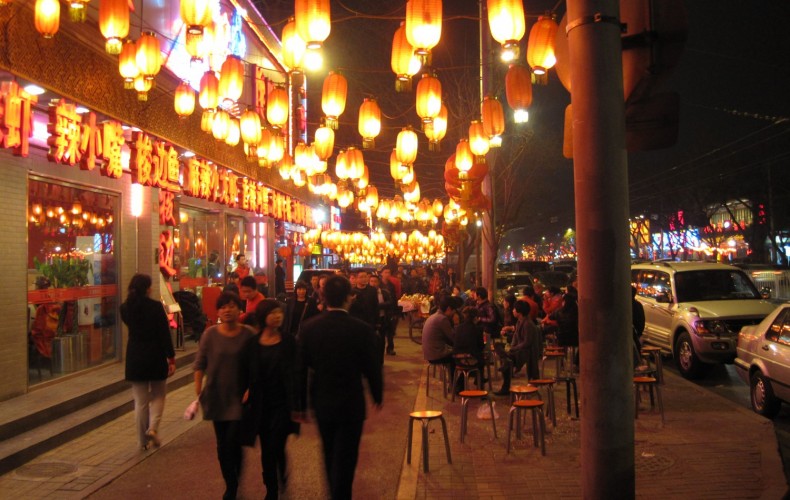 I took this photo as I walked through a subway in central Beijing, China’s fast-paced capital. The man in the picture, Gao Jie, was playing with his large screen smartphone as I walked past his stand. He runs a street stall, selling a range of products – Thai candles, phone screen protectors and decorative mobile chains. The electric bike in the background is his means of commuting to work. His was sending a WeChat message on his phone K-Touch (a local Chinese brand), which cost him £80 at the time he bought it. When asked how much he could make every month, he was smiling, ‘not too much’, he said. According to official stats, the average monthly salary of Beijing is about £500.
I took this photo as I walked through a subway in central Beijing, China’s fast-paced capital. The man in the picture, Gao Jie, was playing with his large screen smartphone as I walked past his stand. He runs a street stall, selling a range of products – Thai candles, phone screen protectors and decorative mobile chains. The electric bike in the background is his means of commuting to work. His was sending a WeChat message on his phone K-Touch (a local Chinese brand), which cost him £80 at the time he bought it. When asked how much he could make every month, he was smiling, ‘not too much’, he said. According to official stats, the average monthly salary of Beijing is about £500.
It is not rare to see similar cases as Gao in the city. In fact, it is fairly common to see street vendors, delivery boys, security guards and blue collar workers with ‘fancy’ smartphones – and probably more so in Beijing than in London. That’s not because people in Beijing have higher disposable incomes than those in London. In fact my friend who was visiting China with me is an Austrian national and was completely shocked by what he saw. “Why do these people have smartphones?’. He had assumed that most people like Gao in Beijing would use feature phones or something more basic.
His question was halfway answered when we walked into a local mobile phone store. The Hisense 966, a 5-inch quad-core smartphone with 2G RAM is priced less than £40, and this is just one among many local brands doing in-store promotions. Surprisingly, the deals weren’t attracting many customers – the store was half empty and there were more sales staff than customers. One of the staff told me that these days, consumers prefer to buy mobile phones online, for the additional freebies (such as a free phone cases, back-up battery or a sim-card cutter from the seller).

The Rise of Local Brands
The Chinese market used to be dominated by Apple and Samsung, but this has been rapidly changing since 2013. Local mobile phone brands are now catching up by producing competitive products at more affordable prices, which is proving to be appealing to Chinese consumers.
A good example is hot-selling Chinese smartphone maker Xiaomi, which is taking away dedicated iPhone fans from Apple. Xiaomi smartphones may have started off as a ‘knock-off’ iPhone, running on an Android operating system, but they have now demonstrated their innovative credentials and are endorsed by consumers for their ease to use, high performance and low price. In fact, Xiaomi has numerous customisable features that make the smart more advanced in some ways.
Since December 2013, Xiaomi has beaten iPhone and Samsung, becoming the bestseller smartphone brand in China. While capturing a significant share of the domestic market, Xiaomi have also had some success in other Asian markets – in Singapore, for example, batches of Xiaomi phones sold out within a few minutes of being launched in 2014. The company plans to sell 40 million handsets in 2014, which is more than double the number it sold in 2013. Brands like Xiaomi may be little known outside China (especially in Europe), yet their rapid development is quickly changing existing market dynamics and challenging our way of thinking.
Another half of the answer to the smartphone’s penetration can be found by understanding the Chinese mentality when it comes to technology. In 2012, a 17-year-old teenager notoriously sold one of his kidneys in order to afford an iPhone – shocking the national press. The focus of the story in Western media was on illegal organ trading, while the Chinese media was busy criticising the failure of education or materialistic values. Hardly anybody paid enough attention to the reason behind the trade-off from the teenager’s perspective. Naturally I wouldn’t agree with (or encourage) behavior of this kind, but I do believe that there may have been strong motivations making the young man so determined to trade part of his body for the ideal smartphone.
This left me trying from another perspective to understand how a smartphone could be believed to be so important to an individual. From a cultural standpoint, China is not the best place to talk about freedom. Social norms, family expectations, political constraints and singular definition of success…all of these contribute to the formation of conformist individuals and a collective society as a whole. Unlike the social environment, a smartphone offers open sources (e.g. free applications), equal accessibility to information (e.g. the internet) and opportunities to stand out in non-traditional ways, providing the chance to challenge the status quo and to fully develop individual potential. In a nutshell, it is the freedom that technology brings which turns a smartphone into a magic wand.
The crazy organ selling incident has been almost forgotten since it happened two years ago. What hasn’t changed much is the desire and appetite for advanced technology in China. With an up-to-date touch screen smartphone, consumers are being empowered with the freedom to express themselves and explore the world – a kind of freedom that is incredibly valued by the Chinese and especially by younger generations.


On our way back, my friend was once again surprised by how young the Chinese technology consumers were. We kept seeing kids running into mobile phone stores with their parents, or using their own devices in public spaces. Those young people who were born after 1990 or 2000 seem to have more progressive, exploratory attitudes and behaviours around technology and smartphones, compared to those in their late 20s or early 30s. How to appeal to this zealous, fast-changing and increasingly domestically-led market that we see in urban China is a question that marketers and businesses will need to consider.
Michelle
[1] [http://www.chinaabout.net/beijing-2012-average-monthly-salary-reached-5223-yuan-us-836/]
[2] http://www.bloomberg.com/news/2014-04-08/china-s-xiaomi-plans-to-give-the-world-iphone-cool-at-half-price.html
[3] http://www.reuters.com/article/2014/01/02/us-china-xiaomi-idUSBREA010B920140102














